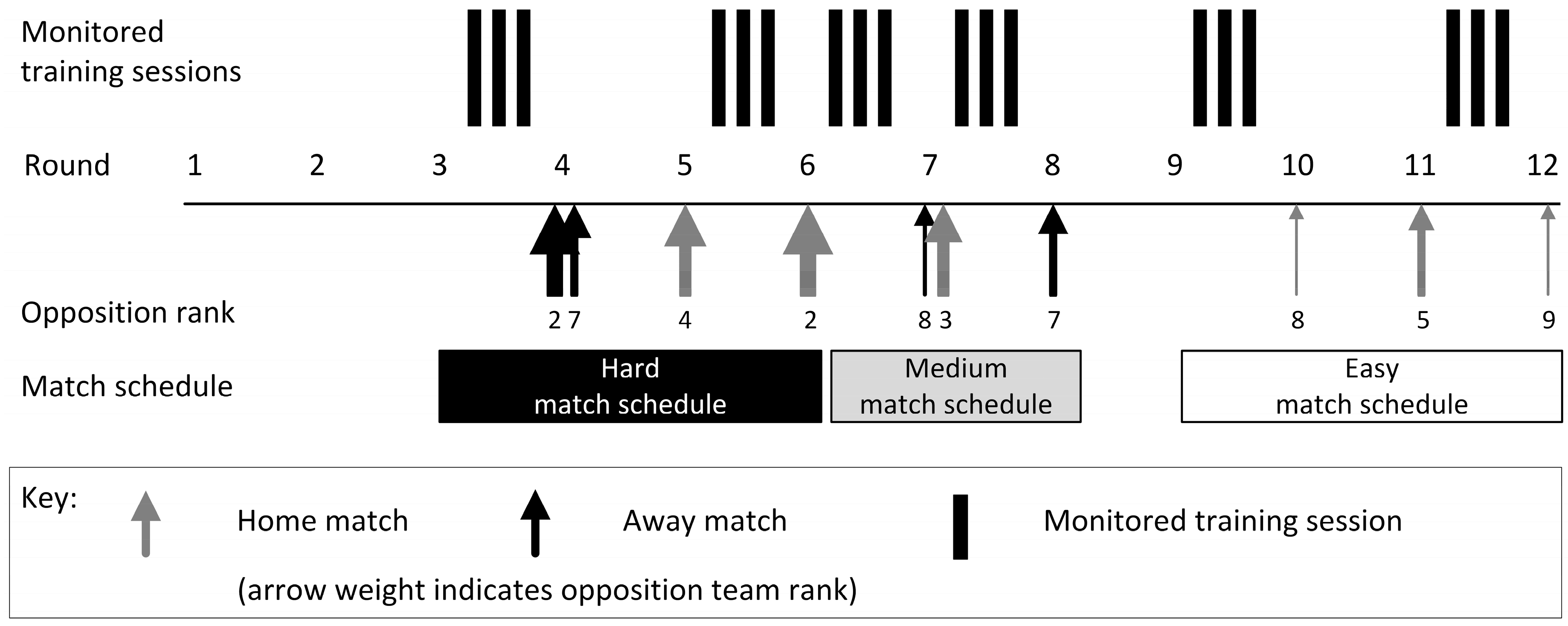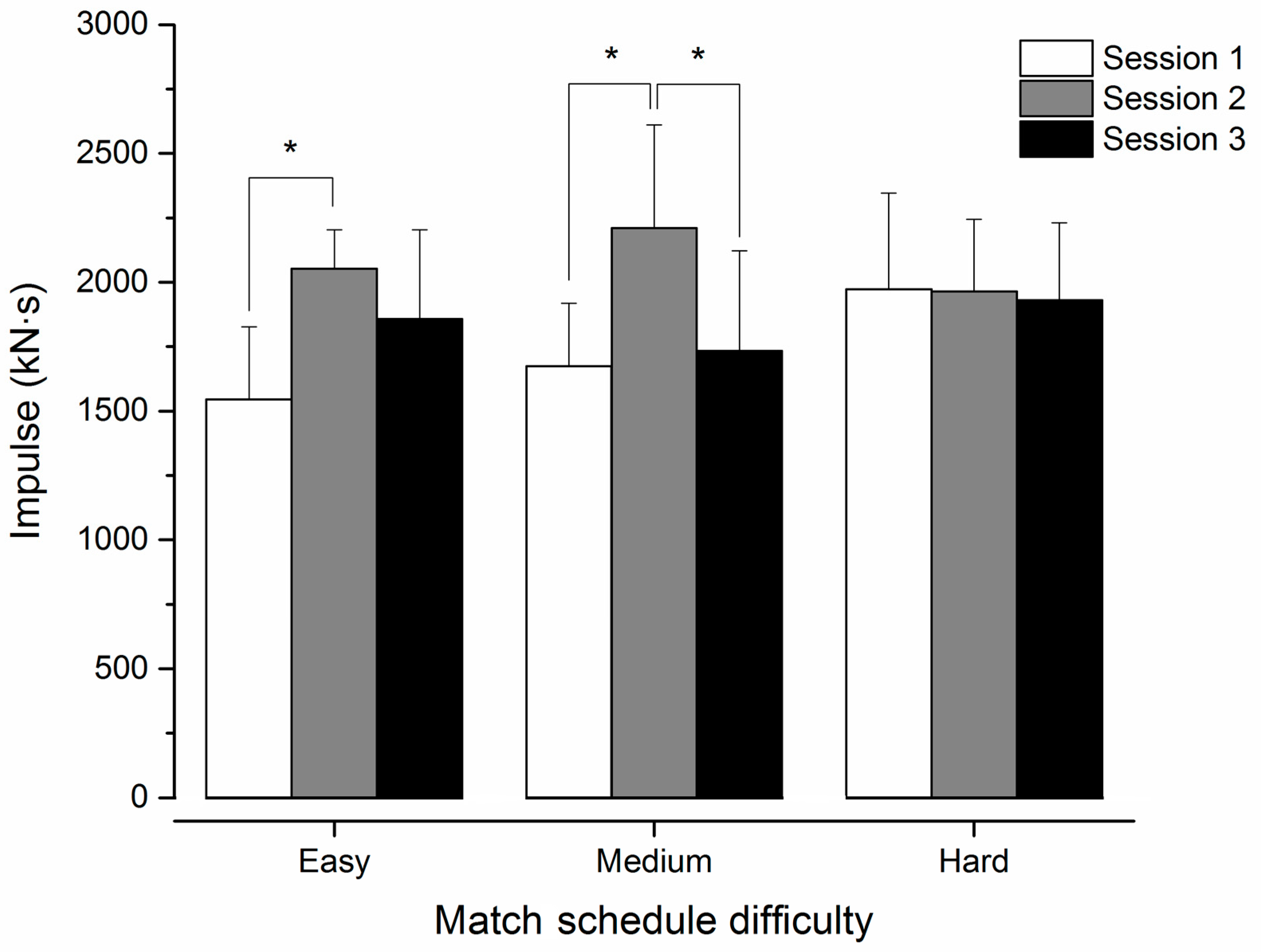The Effect of Match Schedule on Accelerometry-Derived Exercise Dose during Training Sessions throughout a Competitive Basketball Season
Abstract
1. Introduction
2. Materials and Methods
2.1. Participants
2.2. Study Design
2.3. Data Analyses
2.4. Statistical Analyses
3. Results
4. Discussion
5. Conclusions
Author Contributions
Funding
Acknowledgments
Conflicts of Interest
References
- Manzi, V.; D’Ottavio, S.; Impellizzeri, F.M.; Chaouachi, A.; Chamari, K.; Castagna, C. Profile of weekly training load in elite male professional basketball players. J. Strength Cond. Res. 2010, 24, 1399–1406. [Google Scholar] [CrossRef] [PubMed]
- Abdelkrim, N.B.; El Fazaa, S.; El Ati, J. Time–motion analysis and physiological data of elite under-19-year-old basketball players during competition. Br. J. Sports Med. 2007, 41, 69–75. [Google Scholar] [CrossRef] [PubMed]
- Conte, D.; Favero, T.G.; Lupo, C.; Francioni, F.M.; Capranica, L.; Tessitore, A. Time-motion analysis of Italian elite women’s basketball games: Individual and team analyses. J. Strength Cond. Res. 2015, 29, 144–150. [Google Scholar] [CrossRef] [PubMed]
- Montgomery, P.G.; Pyne, D.B.; Minahan, C.L. The physical and physiological demands of basketball training and competition. Int. J. Sports Physiol. Perform. 2010, 5, 75–86. [Google Scholar] [PubMed]
- Narazaki, K.; Berg, K.; Stergiou, N.; Chen, B. Physiological demands of competitive basketball. Scand. J. Med. Sci. Sports 2009, 19, 425–432. [Google Scholar] [CrossRef] [PubMed]
- Scanlan, A.; Dascombe, B.; Reaburn, P. A comparison of the activity demands of elite and sub-elite Australian men’s basketball competition. J. Sports Sci. 2011, 29, 1153–1160. [Google Scholar] [CrossRef] [PubMed]
- Staunton, C.; Wundersitz, D.; Gordon, B.; Kingsley, M. Accelerometry-derived relative exercise intensities in elite women’s basketball. Int. J. Sports Med. 2018. [Google Scholar] [CrossRef] [PubMed]
- Fox, J.L.; Stanton, R.; Scanlan, A. A Comparison of Training and Competition Demands in Semiprofessional Male Basketball Players. Res. Q. Exerc. Sport 2018, 89, 103–111. [Google Scholar] [CrossRef] [PubMed]
- Scanlan, A.; Dascombe, B.J.; Reaburn, P.; Dalbo, V.J. The physiological and activity demands experienced by Australian female basketball players during competition. J. Sci. Med. Sport 2012, 15, 341–347. [Google Scholar] [CrossRef] [PubMed]
- Rodriguez-Alonso, M.; Fernandez-Garcia, B.; Perez-Landaluce, J.; Terrados, N. Blood lactate and heart rate during national and international women’s basketball. J. Sports Med. Phys. Fit. 2003, 43, 432–436. [Google Scholar]
- Moreira, A.; McGuigan, M.R.; Arruda, A.F.; Freitas, C.G.; Aoki, M.S. Monitoring internal load parameters during simulated and official basketball matches. J. Strength Cond. Res. 2012, 26, 861–866. [Google Scholar] [CrossRef] [PubMed]
- Stojanović, E.; Stojiljković, N.; Scanlan, A.T.; Dalbo, V.J.; Berkelmans, D.M.; Milanović, Z. The Activity Demands and Physiological Responses Encountered During Basketball Match-Play: A Systematic Review. Sports Med. 2018, 48, 111–135. [Google Scholar] [CrossRef] [PubMed]
- Staunton, C.; Wundersitz, D.; Gordon, B.; Kingsley, M. Construct validity of accelerometry-derived force to quantify basketball movement patterns. Int. J. Sports Med. 2017, 38, 1090–1096. [Google Scholar] [CrossRef] [PubMed]
- Xu, F.; Rhodes, E.C. Oxygen uptake kinetics during exercise. Sports Med. 1999, 27, 313–327. [Google Scholar] [CrossRef] [PubMed]
- Fudge, B.W.; Wilson, J.; Easton, C.; Irwin, L.; Clark, J.; Haddow, O.; Kayser, B.; Pitsiladis, Y.P. Estimation of oxygen uptake during fast running using accelerometry and heart rate. Med. Sci. Sports Exerc. 2007, 39, 192–198. [Google Scholar] [CrossRef] [PubMed]
- McGregor, S.J.; Busa, M.A.; Yaggie, J.A.; Bollt, E.M. High resolution MEMS accelerometers to estimate VO2 and compare running mechanics between highly trained inter-collegiate and untrained runners. PLoS ONE 2009, 4, e7355. [Google Scholar] [CrossRef] [PubMed]
- Medbo, J.I.; Mohn, A.-C.; Tabata, I.; Bahr, R.; Vaage, O.; Sejersted, O.M. Anaerobic capacity determined by maximal accumulated O2 deficit. J. Appl. Physiol. 1988, 64, 50–60. [Google Scholar] [CrossRef] [PubMed]
- Noordhof, D.A.; De Koning, J.J.; Foster, C. The maximal accumulated oxygen deficit method. Sports Med. 2010, 40, 285–302. [Google Scholar] [CrossRef] [PubMed]
- Scott, C.; Roby, F.; Lohman, T.; Bunt, J. The maximally accumulated oxygen deficit as an indicator of anaerobic capacity. Med. Sci. Sports Exerc. 1991, 23, 618–624. [Google Scholar] [CrossRef] [PubMed]
- Marfell-Jones, M.J.; Stewart, A.; de Ridder, J. International Standards for Anthropometric Assessment; ISAK: Potchefstroom, South Africa, 2012. [Google Scholar]
- Aadland, E.; Ylvisåker, E. Reliability of the Actigraph GT3X+ accelerometer in adults under free-living conditions. PLoS ONE 2015, 10, e0134606. [Google Scholar] [CrossRef] [PubMed]
- Santos-Lozano, A.; Torres-Luque, G.; Marín, P.J.; Ruiz, J.R.; Lucia, A.; Garatachea, N. Intermonitor variability of GT3X accelerometer. Int. J. Sports Med. 2012, 33, 994–999. [Google Scholar] [CrossRef] [PubMed]
- McClain, J.J.; Sisson, S.B.; Tudor-Locke, C. Actigraph accelerometer interinstrument reliability during free-living in adults. Med. Sci. Sports Exerc. 2007, 39, 1509–1514. [Google Scholar] [CrossRef] [PubMed]
- Boonstra, M.C.; van der Slikke, R.M.; Keijsers, N.L.; van Lummel, R.C.; de Waal Malefijt, M.C.; Verdonschot, N. The accuracy of measuring the kinematics of rising from a chair with accelerometers and gyroscopes. J. Biomech. 2006, 39, 354–358. [Google Scholar] [CrossRef] [PubMed]
- Dalen, T.; Jørgen, I.; Gertjan, E.; Havard, H.G.; Ulrik, W. Player Load, Acceleration, and Deceleration During Forty-Five Competitive Matches of Elite Soccer. J. Strength Cond. Res. 2016, 30, 351–359. [Google Scholar] [CrossRef] [PubMed]
- Wundersitz, D.; Gastin, P.; Robertson, S.; Davey, P.; Netto, K. Validation of a Trunk-mounted Accelerometer to Measure Peak Impacts during Team Sport Movements. Int. J. Sports Med. 2015, 36, 742–746. [Google Scholar] [CrossRef] [PubMed]
- Wundersitz, D.; Gastin, P.B.; Robertson, S.J.; Netto, K.J. Validity of a Trunk Mounted Accelerometer to Measure Physical Collisions in Contact Sports. Int. J. Sports Physiol. Perform. 2015, 10, 681–686. [Google Scholar] [CrossRef] [PubMed]
- Pescatello, L.S.; Arena, R.; Riebe, D.; Thompson, P.D. ACSM’s Guidelines for Exercise Testing and Prescription, 9th ed.; Wolters Kluwer Health/Lippincott Williams & Wilkins: Philadelphia, PA, USA, 2014. [Google Scholar]
- Torres-Ronda, L.; Ric, Á.; de Miguel, B.; llabres, I.; Schelling, X. Position-Dependent Cardiovascular Response and Time-Motion Analysis during Training Drills and Friendly Matches in Elite Male Basketball Players. J. Strength Cond. Res. 2016, 30, 60–70. [Google Scholar] [CrossRef] [PubMed]
- Schelling, X.; Torres-Ronda, L. Conditioning for basketball: Quality and quantity of training. Strength Cond. J. 2013, 35, 89–94. [Google Scholar] [CrossRef]
- Castagna, C.; Impellizzeri, F.M.; Chaouachi, A.; Abdelkrim, B.N.; Manzi, V. Physiological responses to ball-drills in regional level male basketball players. J. Sports Sci. 2011, 29, 1329–1336. [Google Scholar] [CrossRef] [PubMed]
- Klusemann, M.J.; Pyne, D.B.; Foster, C.; Drinkwater, E.J. Optimising technical skills and physical loading in small-sided basketball games. J. Sports Sci. 2012, 30, 1463–1471. [Google Scholar] [CrossRef] [PubMed]
- Scanlan, A.; Wen, N.; Tucker, P.S.; Dalbo, V.J. The Relationships Between Internal and External Training Load Models During Basketball Training. J. Strength Cond. Res. 2014, 28, 2397. [Google Scholar] [CrossRef] [PubMed]
- Sampaio, J.; Abrantes, C.; Leite, N. Power, heart rate and perceived exertion responses to 3x3 and 4x4 basketball small-sided games. Rev. Psicol. Deporte 2009, 18, 463–467. [Google Scholar]
- Gabbett, T.J. GPS analysis of elite women’s field hockey training and competition. J. Strength Cond. Res. 2010, 24, 1321–1324. [Google Scholar] [CrossRef] [PubMed]
- Anderson, L.; Triplett-Mcbride, T.; Foster, C.; Doberstein, S.; Brice, G. Impact of training patterns on incidence of illness and injury during a women’s collegiate basketball season. J. Strength Cond. Res. 2003, 17, 734–738. [Google Scholar] [CrossRef]
- Bosquet, L.; Montpetit, J.; Arvisais, D.; Mujika, I. Effects of tapering on performance: A meta-analysis. Med. Sci. Sports Exerc. 2007, 39, 1358–1365. [Google Scholar] [CrossRef] [PubMed]


| Sedentary | Very Light | Light | Moderate | Vigorous | Maximal | Supra-Maximal | |
|---|---|---|---|---|---|---|---|
| Easy | |||||||
| front-court | 38.5 ± 10.0 | 22.3 ± 5.6 | 12.1 ± 4.7 | 11.0 ± 3.3 | 11.5 ± 2.7 | 2.3 ± 1.0 | 2.2 ± 1.4 |
| back-court | 45.9 ± 7.6 | 16.4 ± 1.4 | 9.4 ± 2.9 | 10.2 ± 4.4 | 11.2 ± 1.2 | 3.3 ± 1.4 | 3.6 ± 1.7 |
| Medium | |||||||
| front-court | 40.7 ± 13.1 | 21.6 ± 5.8 | 11.9 ± 4.9 | 10.3 ± 3.7 | 11.6 ± 3.8 | 2.4 ± 0.6 | 1.4 ± 0.5 * |
| back-court | 52.2 ± 4.1 | 14.4 ± 1.0 | 7.2 ± 1.6 | 6.7 ± 1.6 | 9.9 ± 4.1 | 3.6 ± 1.4 | 5.9 ± 2.2 |
| Hard | |||||||
| front-court | 43.8 ± 10.7 | 20.8 ± 5.2 | 10.9 ± 5.6 | 8.6 ± 2.4 | 12.0 ± 3.4 | 2.5 ± 0.9 | 1.3 ± 0.5 |
| back-court | 51.8 ± 6.4 | 14.4 ± 1.0 | 6.7 ± 2.0 | 6.8 ± 1.6 | 10.2 ± 4.7 | 3.5 ± 1.5 | 7.0 ± 5.8 |
| Total | |||||||
| front-court | 40.8 ± 10.9 | 21.6 ± 5.4 * | 11.7 ± 4.8 | 10.1 ± 2.8 | 11.7 ± 3.0 | 2.4 ± 0.6 | 1.7 ± 0.7 |
| back-court | 50.2 ± 4.4 | 14.8 ± 6.7 | 7.8 ± 1.8 | 7.8 ± 2.0 | 10.3 ± 3.2 | 3.5 ± 0.9 | 5.6 ± 2.7 |
© 2018 by the authors. Licensee MDPI, Basel, Switzerland. This article is an open access article distributed under the terms and conditions of the Creative Commons Attribution (CC BY) license (http://creativecommons.org/licenses/by/4.0/).
Share and Cite
Staunton, C.; Wundersitz, D.; Gordon, B.; Custovic, E.; Stanger, J.; Kingsley, M. The Effect of Match Schedule on Accelerometry-Derived Exercise Dose during Training Sessions throughout a Competitive Basketball Season. Sports 2018, 6, 69. https://doi.org/10.3390/sports6030069
Staunton C, Wundersitz D, Gordon B, Custovic E, Stanger J, Kingsley M. The Effect of Match Schedule on Accelerometry-Derived Exercise Dose during Training Sessions throughout a Competitive Basketball Season. Sports. 2018; 6(3):69. https://doi.org/10.3390/sports6030069
Chicago/Turabian StyleStaunton, Craig, Daniel Wundersitz, Brett Gordon, Edhem Custovic, Jonathan Stanger, and Michael Kingsley. 2018. "The Effect of Match Schedule on Accelerometry-Derived Exercise Dose during Training Sessions throughout a Competitive Basketball Season" Sports 6, no. 3: 69. https://doi.org/10.3390/sports6030069
APA StyleStaunton, C., Wundersitz, D., Gordon, B., Custovic, E., Stanger, J., & Kingsley, M. (2018). The Effect of Match Schedule on Accelerometry-Derived Exercise Dose during Training Sessions throughout a Competitive Basketball Season. Sports, 6(3), 69. https://doi.org/10.3390/sports6030069







